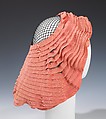Snood
Designer Sally Victor American
Not on view
During the 1930s, '40s and the early '50s, when hats were considered required accessories for well-dressed women, Sally Victor was among the foremost American milliners. Creative and very successful for almost 40 years, Victor began her prolific millinery career in 1927. She was one of the original members of the Edward C. Blum Design Laboratory, and often used the Brooklyn Museum's varied collections to draw inspiration for her designs. She was so connected with the Design Lab that she participated in several collaborative exhibitions and the museum often used her designs in publicity materials to exemplify how the Lab could benefit designers by providing inspiration. Her work is characterized by a special quirkiness that could often be traced back to interesting sources such as Native American tribes, the artist Henri Matisse or Japanese armor. She also combined traditional hat-making materials such as felt and silk with new synthetic materials in unique ways. According to her May 16, 1977 obituary in the "New York Times," Victor described her mission simply as "designing pretty hats that make women look prettier."
Victor experimented with concentric and collapsible construction throughout her career, partially inspired by studies of Japanese armor. This inventive example incorporates ribbons rather than felt or straw, which she used in later designs, such as the well-known "Airwaves" hat (see 2009.300.1175). The ribbons, in a playful pink shade, wrap around the head in an undulating fashion, creating the effect of a soft wavy hairstyle. The net snood would secure the wearer's actual hair, while the waves of ribbons would give the illusion of a fashionable coif. Victor was intrigued by the versatility offered by collapsible and circular hats, and felt she was creating something for her customers that was easy to travel with and easy to wear.
Due to rights restrictions, this image cannot be enlarged, viewed at full screen, or downloaded.

